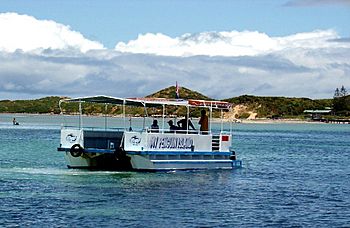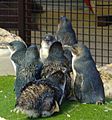Penguin Island (Western Australia) facts for kids

Penguin Island and ferry
|
|
| Geography | |
|---|---|
| Location | Indian Ocean |
| Coordinates | 32°18′19″S 115°41′28″E / 32.30528°S 115.69111°E |
| Administration | |
Penguin Island is a 12.5 ha (31 acres) island off the coast near Perth, approximately 660 m (722 yd) from Shoalwater. It is home to a colony of approximately 250 little penguins, the largest population of the birds in Western Australia. Since 2007, the island had experienced an 80 percent decline in penguin numbers from a peak of 1,700 that year.
The waters surrounding the island make up the Shoalwater Islands Marine Park.
Contents
Getting to the Island
Regular ferries carry tourists to and from the island and other marine-park sights, the journey taking 5 minutes from Mersey point. The island can also be reached by private boat, kayaking, swimming, or walking across a tidal sandbar, which is often exposed above sea level at low tide for a large portion of its 700-metre length, however at high tide, most of the sandbar is under varying depths of water. The Department of Environment and Conservation (DEC) advises against the sandbar walk as weather conditions can change quickly, making the crossing dangerous, which has resulted in several drownings.
Island Facilities
Visitors should take their own supply of food and drink, since none can be purchased on Penguin Island, though there is a picnic area with seating and water taps, and waterless composting toilets.
Litter bins are not provided on the island and all visitors are required to take away their own rubbish. This is to remove potential food sources for destructive animals such as black rats, which have previously led to a reduction in the penguin population. In 2013 a successful baiting program was conducted to eliminate a rat population that had become established on the island.
Island Features
In addition to the colony of little penguins there are many other sights including nesting seabirds and a 500-strong colony of pelicans.
Penguin Island has many geographical features, such as cliffs, small sea caves, headlands, beaches, coves, notches and natural bridges. There are also numerous wave-cut platforms.
Significant areas of Penguin Island include North Rock, Pelican Bluff, North Beach, McKenzies Well, South Beach, Abalone Point, and Surfers Beach.
There are numerous lookouts, boardwalks and walkways throughout most of the island. Some areas are fenced off to the public to protect wildlife and lessen dune erosion.
Rescue Penguins
A small population of rescued penguins are kept in a dedicated enclosure on the island (known as the Discovery Centre) which was built by the Department of Environment and Conservation in 1987. As well as being a sanctuary to care for injured wild penguins, it is also the home of the 10 resident penguins that have been badly injured, orphaned as chicks or born in captivity, and it is unlikely that they would survive in the wild. It has been designed to reflect the penguins natural sandy, coastal scrub environment and includes a saltwater pond with viewing panels to watch the little penguins swim. Penguin feedings are held three times daily by a Wildlife ranger.
Little Penguin Population
Spotting wild little penguins at the island is unusual as for most of the year, daylight hours are spent at sea chasing fish, and visitors are strictly prohibited from being on the island except during specified daylight hours from mid-September to early June.
The little penguin population which breeds on Penguin Island is genetically distinct and in decline. In 2007 there were between 1600 and 2000 little penguins on Penguin Island during breeding months. By 2011, the number had dropped to about 1000. Penguins have been observed taking longer foraging trips leading to chick malnutrition and starvation. Prey depletion and climate change are considered to be major pressures on the breeding population. A proposal to construct a marina at Point Peron is also considered a future threat. A number of rescued penguins are kept in a dedicated enclosure for visitors to the island to observe.
Little penguins also breed on nearby Garden Island, 6.5 km to the north. The two colonies are considered as a single meta-population. In 2007, the meta-population was estimated to include a total of 2369 individuals.
Historically, the penguins of Penguin Island have been victims of dog attacks and shooting by holiday-makers. An informal assessment of the Penguin Island colony was made by Vincent Serventy in 1946. After several visits, he estimated the colony to number approximately 500 pairs. In the 1940s concern was expressed for the viability of the penguin colony on Penguin Island, due to combined threats of human landing parties with guns and dogs, occasional fires, and an abundance of rabbits which were denuding the island of its former vegetation and accelerating its erosion. Rabbits were believed to have been introduced to the island in the 1920s, and numbered approximately four to five thousand in the late 1940s. By 1950, it had become an illegal act to take a dog to Penguin Island.
Penguins were present on Penguin Island in the 1900s, 1910s and 1920s. Seals were also known to haul out on the island around this time.
Image gallery
Transport
Regular ferries carry tourists to and from the island and other marine-park sights, the journey taking 5 minutes from Mersey point. The island can also be reached by private boat, kayaking, swimming, or walking across a tidal sandbar, which is often exposed above sea level at low tide for a large portion of its 700 m (766 yd) length, however at high tide, most of the sandbar is under varying depths of water. The Department of Parks and Wildlife (DPAW) advises against the sandbar walk as weather conditions can change quickly, making the crossing dangerous, which has resulted in several drownings.







